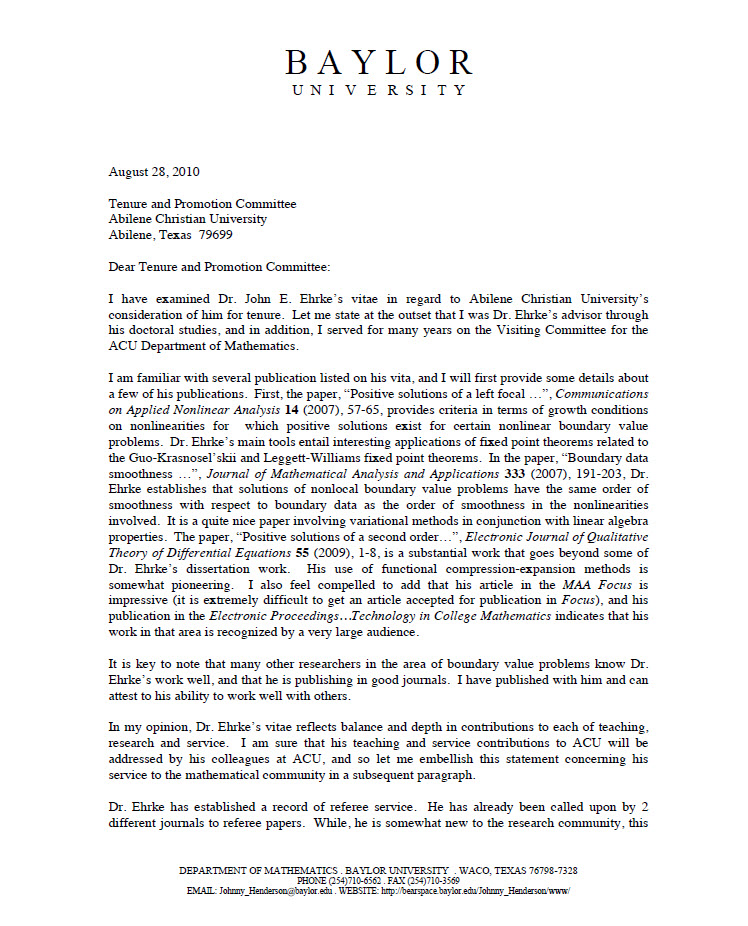Publications at ACU 2007-2012
- Henderson, Johnny, Ehrke, John, and Kunkel, C. Five-point boundary value problems for nth order differential equations by solution matching, Involve: A Journal of Mathematics, 1 (2008), 1-7.
- Ehrke, John. What I learned from…catching iPhone fever, MAA Focus, August/September 2009, 28-29.
- Ehrke, John. Encouraging the integration of complex numbers in undergraduate ordinary differential equations, Texas College Mathematics Journal, 6 (2009), 18-24.
- Ehrke, John. Positive solutions of a second order, three point boundary value problem via functional compression-expansion. Electronic Journal of Qualitative Theory of Differential Equations, 55 (2009), 1-8.
- Ehrke, John. Course blogs and the iPhone: Applications at all levels of undergraduate mathematics, Electronic Proceedings of the International Conference of Technology in College Mathematics, 2010.
Publications before ACU 2006-2007
- Ehrke, John. Positive solutions of a left focal second order boundary value problem, Communications on Applied Non-Linear Analysis, 14 (2007), 57-65.
- Henderson J., Kunkel C., Ehrke J., and Sheng Q. Boundary data smoothness for solutions of nonlocal boundary value problems for second order differential equations, Journal of Mathematical Analysis and Applications, 333 (2007), 191-203.
Refereed Articles
- Multiple positive solutions for second order m-point boundary value problems, Journal of Mathematical Analysis and Applications, Manuscript No. = JMAA-05-2540.
- Positive solutions for second order three point boundary value problems, Journal of Abstract and Applied Analysis, Manuscript No. = AAA/236926.v2.
- Positive solutions for nth order nonlinear impulsive singular integro-differential equations on infinite intervals in Banach spaces, Journal of Nonlinear Analysis, Manuscript No. = NA-D-07-01235.
______________________________________________________________________
Reflections on Publications
The publication, Five point boundary value problems nth order differential equations by solution matching, represents a collaborative work begun at Baylor University during my final month there, continued into the summer after being hired at ACU, and was published in the beginning of the following year. This work afforded me the opportunity of working on my first true collaboration, as much of the work was done via email submissions to the differential equations team at Baylor.
As I settled into my teaching duties after the first year and began focusing on utilizing iOS devices in the classroom I developed a set of calculator tutorials for use by students in MATH 120. These tutorials, my use of the devices in class. and my experiences from the second year of teaching with the devices, prompted me to submit the What I Learned From.. Catching iPhone Fever article to the MAA Focus. To be honest, I’m not sure I expected it to be accepted since it was the first article of that type I had ever endeavored to write. To my surprise, the article was well received by the editors and published in August, merely a month after being received. The response to the article was overwhelming. The MAA Focus is an internationally circulated production of the Mathematical Association of America and has a wide readership. It contains information about MAA activities news about mathematics and the mathematical community, and lively articles about interesting new (or sometimes not so new) ideas in mathematics, mathematics education and related areas that have the potential to transform the field. The article led to more opportunities beginning with an ICTCM conference presentation invite and spurred me to apply for a Mobile Learning Fellowship the following year.
Despite my work with the Mobile Learning Initiative, I felt I wanted to return to work prompted by my dissertation and experiences in teaching differential equations (my field) in my first two years. This led first to the article, Positive solutions of a second order, three point boundary value problem via functional compression-expansion published in the Electronic Journal of Qualitative Theory of Differential Equations (EJQTDE). For people in my field this is a top journal with an exceptional group of editors. The journal has an impact rating of 0.471 and is an international publication. In addition, I was able to publish in the Texas College Mathematics Journal about a topic that I thought deserved attention among small school differential equations’ teachers, namely, The Integration of Complex Numbers in Undergraduate Ordinary Differential Equations. The editor was very complimentary of the article, and I have received numerous subsequent correspondences from readers.
_________________________________________________________________________

